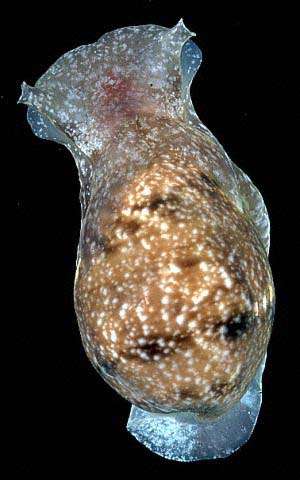
Bulla ampulla
Linnaeus, 1758
Order: CEPHALASPIDEA
Family: Bullidae
DISTRIBUTION
Found throughout the tropical Indo-West Pacific.
PHOTO
Koumac, northern New Caledonia, October 1993. PHOTO: Bill Rudman.
Species of Bulla are found both in tropical and temperate waters. They are herbivorous but they seem to be quite unrelated to any other herbivorous group or to any other group of opisthobranchs for that matter. They have a strange relatively soft radula, and the gizzard has three large crushing plates and ancillary spines rather than the grinding plates of the other herbivores such as Haminoea. The Bullidae seem to have evolved separately from a very early stage in the evolutionary history of the opisthobranchs, although some recent hypotheses disagree with this interpretation.
All species of Bulla have very similarly shaped shells and there is clearly some confusion in their taxonomy at present. Unfortunately little difference has been found in the morphology of the radular teeth, or any other part of the anatomy, of the species of the genus that have been investigated. See my comments on Bulla vernicosa and other similar species in my reply to messages #1511 and #15367.
They appear to be nocturnal, burrowing in soft sediment or hiding under coral slabs during the day.
-
Rudman,W.B.(1971). Structure and functioning of the gut in the Bullomorpha (Opisthobranchia). Part 1. Herbivores. Journal of Natural History, 5: 647-675.
Rudman, W.B., 1998 (December 18) Bulla ampulla Linnaeus, 1758. [In] Sea Slug Forum. Australian Museum, Sydney. Available from http://www.seaslugforum.net/find/bullampu
Related messages
Bulla vernicosa? from Philippines
December 5, 2005
From: Marina Poddubetskaia Ossokine
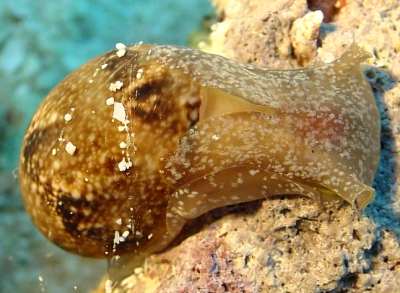
Dear Bill,
In their recent message on Philinopsis cyanea, Francis & Pirjo Pellet identified a small Bulla from the Philippines as Bulla ampulla [#15356]. I am not a Bulla specialist, but during Panglao 2004 expedition (http://www.panglao-hotspot.org) we found many Bulla like this one and Terry Gosliner identified all of them as Bulla vernicosa. I attach here 2 photos of this species for the Forum.
I couldn't tell you how to differentiate it from B. ampulla. Maybe Terry or Manuel Malaquias could tell us more...
Locality: 'Momo Beach', Panglao Island, Philippines, Pacific Ocean. Depth: 0-3 m. Length: 30 mm. 10 June 2004. shallow muddy/sandy bottoms. Photographer: Marina Poddubetskaia Ossokine
Best wishes,
Marina.
Nembro website
nembro@nembro.info
Poddubetskaia Ossokine, M., 2005 (Dec 5) Bulla vernicosa? from Philippines. [Message in] Sea Slug Forum. Australian Museum, Sydney. Available from http://www.seaslugforum.net/find/15367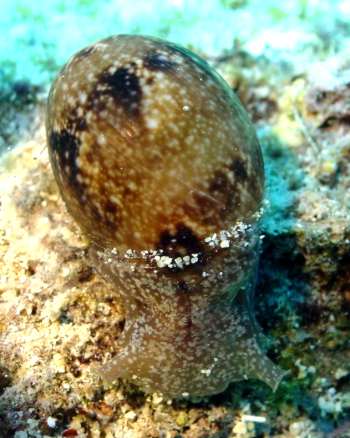
Dear Marina,
I began a reply to your question and then realised I had already discussed this question in a reply some time ago to a message from Atsushi Ono [#1511 ].
I've had another look at our quite large collection of Bulla shells from the Indo-West Pacific and it certainly looks as though colour pattern is variable within populations and inflated 'typical' B. ampulla shells are inevitably large and mixed with smaller shells which are narrower at the apical end. A supposed charcter of B. vernicosa is a narrowing of the aperture of the shell - which we can't see in photos of the live animals.
What is a major problem is that Bulla vernicosa was never figured in Gould's original description, and no specimen was found in Gould's collections meaning that it is impossible to know just what Gould meant by the name. In the Willan's 1989 review, which I mention in Ono's message, Willans essentially agrees by starting his remarks with:
"A future monograph on the genus may consider Bulla vernicosa Gould, 1859 to be insufficiently described since the original diagnosis is inadequate and there is no designated type.."
In my opinion there are two separate questions to ask about Bulla. Firstly we need to know how many species there are and whether they vary in shell shape and colour as they grow. Secondly we then need to try and sort out which of the many names that have been given to shells over the last 150 years can be fitted to 'biologcal' species. In the meantime I think it is less confusing to call them all Bulla ampulla. Certainly in large adults, the shell has an inflated, wide, opening but I have found no small shells with a similar shape so I can only assume that smaller animals have a narrower 'B. vernicosa ' shape.
Hopefully Manuel Malaquias's research will make it clearer.
Best wishes,
Bill Rudman
Bulla ampulla laying eggs
May 5, 2005
From: Binyamin Koretz
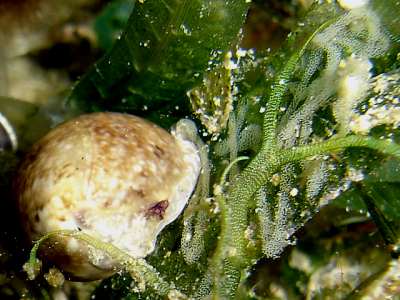
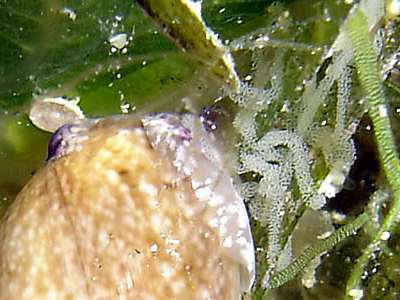
Dear Bill,
Are we correct in thinking that this is Bulla ampulla, laying its eggs in seagrass and algae?
Locality: Eilat, Satil Area, Israel. Red Sea (Gulf of Eilat). Depth: 24 m. Length: ca. 1.5 cm. 30 Apr 2005 (night). sea grass and patch reef. Photographer: Binyamin and Shulamit Koretz
Best regards,
Binyamin
binyamin@koretz.net
Koretz, B., 2005 (May 5) Bulla ampulla laying eggs. [Message in] Sea Slug Forum. Australian Museum, Sydney. Available from http://www.seaslugforum.net/find/13703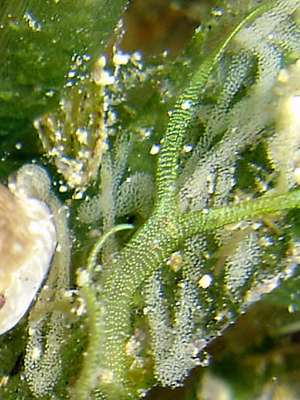
Note added 11 May 2005: See message #13738 suggesting extra eggs are those of Petalifera ramosa.
Dear Binyamin,
This is Bulla ampulla and it certainly appears to be laying eggs. They do look very similar to those in Erwin Kohler's message [#6752] which we suspected were the eggs of Bulla. I think its eggs are those in the tangled string, but I think there are also something elses's eggs on the sea grass leaves. They seem to be deposited in rows across the leaves and are possibly the eggs of a small sea hare such as Phyllaplysia.
Best wishes,
Bill Rudman
Re: Research on Bulla
February 26, 2003
From: Ana Karina Yepes Gomez
I have a doubt about the specimens for molecular analysis shouldn´t they be conserved in ethanol 90%, and not in formalin or ethanol at 70%??
Ana Karina Yepes Gomez
Insituto de Biologia
Universidad de Antioquia (Medellin)
akyepes@hotmail.com
Dear Ana,
Different workers seem to have slightly different preferences ranging from 90% to 100% ethanol. I think it is best to contact Manuel for further information
Cheers,
Bill Rudman
Research on Bulla
January 26, 2003
From: Manuel Malaquias
Dear Friends and Colleagues,
I am just starting my PhD project which is about the systematics and evolution of Bullidae (Gastropoda: Cephalaspidea). This project is being done at The Natural History Museum, London under the supervision of Dr. David Reid. I am hoping to obtain ethanol preserved specimens of Bulla from all around the world for dissection and molecular analyses and I would like to ask for your help in this task.
I am looking for specimens from anywhere, preserved in either formalin or ethanol. If anyone can help I would be very grateful. Please contact me by email or at the address below. In addition, any personal observations of habitats or localities in which Bulla is common would be very welcome.
Thank you very much for your help.
Manuel Antonio E. Malaquias
The Natural History Museum
Molluscan Research Group
Department of Zoology
Cromwell Road, SW7 5BD, London
United Kingdom
Tel (work): 00-44-(0)2079425949
Tel (home): 00-44-(0)2084586689
manm@nhm.ac.uk
Malaquias, M., 2003 (Jan 26) Research on Bulla. [Message in] Sea Slug Forum. Australian Museum, Sydney. Available from http://www.seaslugforum.net/find/9024Spawn of Bulla ampulla?
April 25, 2002
From: Erwin Köhler
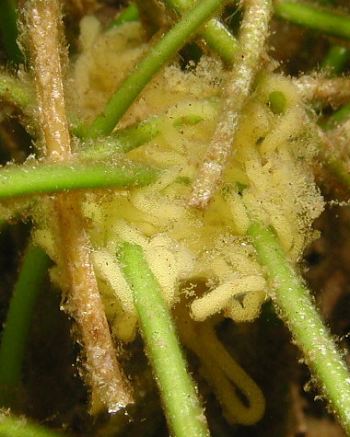
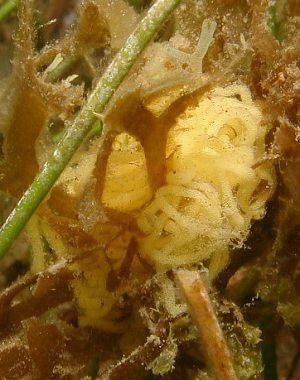
Dear Bill,
Attached are 2 shots of spawn which I think to be from Bulla ampulla
Philippines, Negros Oriental Island, Divesite "Dauin", 07.March 2002, size appr. 3cm, depth 8 m.
Erwin
Erwin@medslugs.de
Köhler, E., 2002 (Apr 25) Spawn of Bulla ampulla?. [Message in] Sea Slug Forum. Australian Museum, Sydney. Available from http://www.seaslugforum.net/find/6752Dear Erwin,
I think this is its egg mass. The egg masses of the Californian Bulla gouldiana are described as looking like this and Kilburn & Rippey (1982)describe the spawn of Bulla ampulla as:
"The spawn is a long, bright yellow to orange, tangled string of jelly, containing a continuous string of tiny oval capsules. Each one contains 1-25 eggs, which develop into free-swimming veliger larvae".
I can't recall actually seeing B. ampulla spawning and the spawn mass of the temperate Australasian species Bulla quoyi is a jelly-like sphere, rather than a long cylinder.
• Kilburn, R. and Rippey, E., (1982) Sea Shells of Southern Africa. Macmillan South Africa, Johannesburg, 249 pp.
Best wishes,
Bill Rudman
Bulla ampulla from the Philippines
March 26, 2002
From: Erwin Köhler
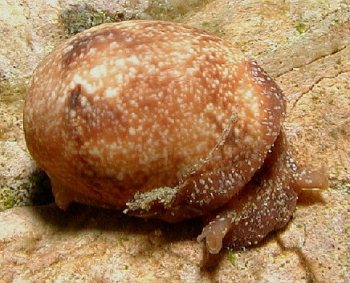
Hi Bill,
I'm back from my recent trip to the Philppines with a lot of doubtful seaslugs (for me, of corse). Here is the first one from Malapascua Island, divesite "Japanese ship wreck", nightdive. Size 4cm, depth 6m, 22.Feb. 2002.
One interesting observation: I didn't find a single specimen of Nembrotha chamberlaini. On my other trips there were at least 2 or 3 at each dive.
Cheers,
Erwin
Erwin@medslugs.de
Köhler, E., 2002 (Mar 26) Bulla ampulla from the Philippines. [Message in] Sea Slug Forum. Australian Museum, Sydney. Available from http://www.seaslugforum.net/find/6541Dear Erwin,
This is Bulla ampulla, which is the common big Bulla in the tropical Indo-West Pacific. Concerning not being able to rely on Nembrotha chamberlaini to turn up for your visit. Nudibranchs are notoriously unreliable. I guess when both and your food have a risky planktonic larval stage, there must always be quite a bit of luck involved in finding your food when you need it.
Look forward to some more mysteries from your trip,
best wishes,
Bill Rudman
Bulla sp. from the Line Islands
November 8, 2001
From: Cory Pittman
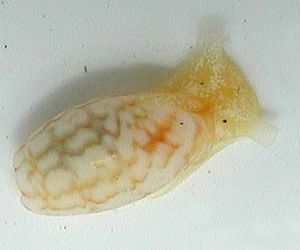
Dear Bill,
During my recent trip [September 2001] to Christmas Island, Line Islands, this juvenile Bulla sp. turned up in a sand sample from about 12 m. It was about 3 mm in length. I suspect it's B. ampulla. There were many shells comparable to that species in drift.
Best wishes,
Cory
norm@maui.net
Pittman, C., 2001 (Nov 8) Bulla sp. from the Line Islands. [Message in] Sea Slug Forum. Australian Museum, Sydney. Available from http://www.seaslugforum.net/find/5556Thanks Cory,
At that size, I'm happy to go along with Bulla ampulla.
Cheers,
Bill Rudman
Bulla gizzard plates
July 11, 2001
From: Paula M. Mikkelsen
In a recent discussion of Bulla ampulla (Cephalaspidea), Bob Bolland (http://rfbolland.com/okislugs/bullampu.htm) made reference to a Sea Slug Forum posting from Bill Rudman {Dec 18, 1998), which says that:
"the gizzard [of Bulla] has four large crushing plates. All other cephalaspids with gizzards (other than the runcinids), have three gizzard plates."
This is in error. All Bulla species in my experience have three near-equal corneous gizzard plates plus additional, smaller, corneous gizzard spines both in front of and behind the plates. The only shelled opisthobranch group with four gizzard plates is the Runcinoidea, and they are indeed still of uncertain phylogenetic affinities. While Bulla's configuration of plates and spines, as well as the shape of its radular teeth, are rather unique among cephalaspids, the evolutionary statements made by Rudman in this posting also need to be adjusted. Bulla, Haminoea and Smaragdinella form a well-defined monophyletic group (Bulloidea) according to my 1996 phylogenetic analysis (Malacologia, 37(2): 375-442).
I am further puzzled by this posting because the Rudman paper cited (1971, J. Nat. Hist. 5: 647-675) clearly discusses three gizzard plates in Quibulla quoyi...
Paula M. Mikkelsen
mikkel@amnh.org
Mikkelsen, P.M., 2001 (Jul 11) Bulla gizzard plates. [Message in] Sea Slug Forum. Australian Museum, Sydney. Available from http://www.seaslugforum.net/find/4797Dear Paula,
Clearly my statement on the website is incorrect and the Rudman paper cited is correct - Bulla has three gizzard plates. What puzzles me is how long it has taken for someone to notice this error on my part. I can give no reason why I said Bulla has 4 gizzard plates - other than the excitement of preparing a collection of bubble shell pages for Xmas 1998 caused some misfirings in my brain. I have made the necessary changes.
Concerning the evolutionary relationships of these animals - I agree, and provided a lot of evidence to show the close relationship between Haminoea, Smaragdinella, Phanerophthalmus and Atys, but I still have strong doubts about relating Bulla to that group. Many features of the alimentary canal, and the reproductive system just do not fit well with the Haminoeoidea. I may be wrong, you may be wrong, but that's the nature of hypothesising about phylogeny. Basically our disagreement highlights the need for further investigation of these interesting animals.
Best wishes,
Bill Rudman
Juvenile Bulla from Sulawesi
June 7, 2001
From: Lindsay Warren
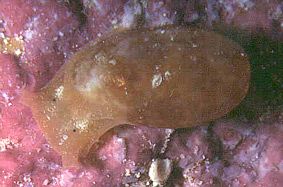
Dear Bill
I wonder whether you could point me in the right direction for the ID of this Bulla found by Guillermo Moreno in July 1999 at a depth of 18 m on filamentous algae growing on the mooring line of a rompong (fish-attracting device) in deep water in the Tukang Besi Archipelago, SE Sulawesi [Operation Wallacea]. On looking at it again (photo) it makes me think of Bulla ampulla but this substrate seems rather unlikely as the adults we have found have always been on/in sand in shallow algae and seagrass beds of the area. Size: 9 mm.
All the best
Lindsay
alldcl@compuserve.com
Warren, L., 2001 (Jun 7) Juvenile Bulla from Sulawesi. [Message in] Sea Slug Forum. Australian Museum, Sydney. Available from http://www.seaslugforum.net/find/4449Dear Lindsay,
I suspect it is Bulla ampulla. When these bubble shells are juvenile their shells are proportionally much lighter and so the animal is much more able to carry the weight vertically. Also being much lighter overall they are much more able to crawl around and in growths of filamentous algae without collapsing the algae.
Best wishes,
Bill Rudman
Live Bulla from Kerama Island, Japan
November 12, 1999
From: Atsushi Ono
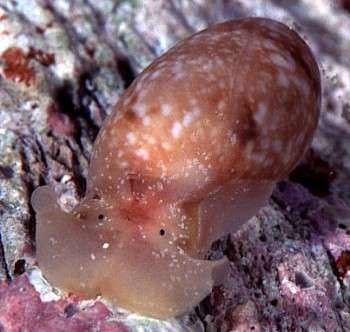
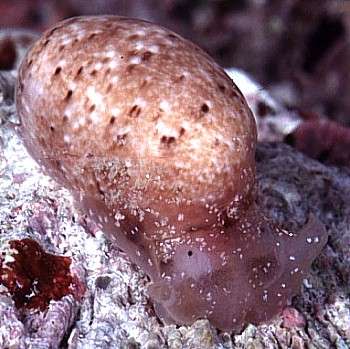
Dear, Bill
I found 2 individuals of CEPHALASPIDEA species at Kerama Is. [near Okinawa in Japan].
Length of shell are about 15mm, at 3m depth.
These are found only at night-diving, on dead coral and sandy bottom.
The lower photo has many dark brown patches on its shell. Are they Bulla ampulla?
Sincerely,
Atsushi Ono
ononini@cosmos.ne.jp
Ono, A., 1999 (Nov 12) Live Bulla from Kerama Island, Japan. [Message in] Sea Slug Forum. Australian Museum, Sydney. Available from http://www.seaslugforum.net/find/1511Dear Atsushi,
Many names and misindentifications surround the species of Bulla found in the Indo-West Pacific. Three species were reviewed by Willan (1978), and two of these, B. vernicosa and B. angasi, would appear to be forms of B. ampulla, which was unfortunately not reviewed. While `typical' B. ampulla has an inflated shell with a rounded outer lip to the aperture, the other two `species' with a narrower aperture and a straight or slightly incurved outer lip, have an identical range of colour patterns. In New Caledonia, specimens ranging from typical B. ampulla in shape to the narrower B. vernicosa-B. angasi shape are found together in mixed populations.
Unfortunately little difference has been found in morphology of the radular teeth, or any other part of the anatomy, of the species of the genus that have been investigated. The radula of B. ampulla and B. vernicosa have been illustrated by Habe (1950) and aspects of the anatomy of B. angasi (as B. subtropicalis) were described by Rudman (1971b).
All tropical western Pacific species have very similarly shaped shells, are herbivorous and nocturnal, burrowing in soft sediment or hiding under coral slabs during the day.
Bulla orientalis Habe, Bulla angasi Pilsbry and Bulla subtropicalis Powell have the distinctive 'comet-like' markings on the shell, as in your lower photo lower shell. I suspect this may be a juvenile colour pattern.
Basically I am not sure and I don't see how question will be resolved, unless a new anatomical character is discovered.
Bill Rudman.
References:
•Willan, R.C. (1978) The nomenclature of three Pacific Bulla species. Journal of the Malacological Society of Australia, 4(1-2): 57-68.
•Rudman,W.B.,1971. Structure and functioning of the gut in the Bullomorpha (Opisthobranchia). Part 1. Herbivores. Journal of Natural History, 5: 647-675.
